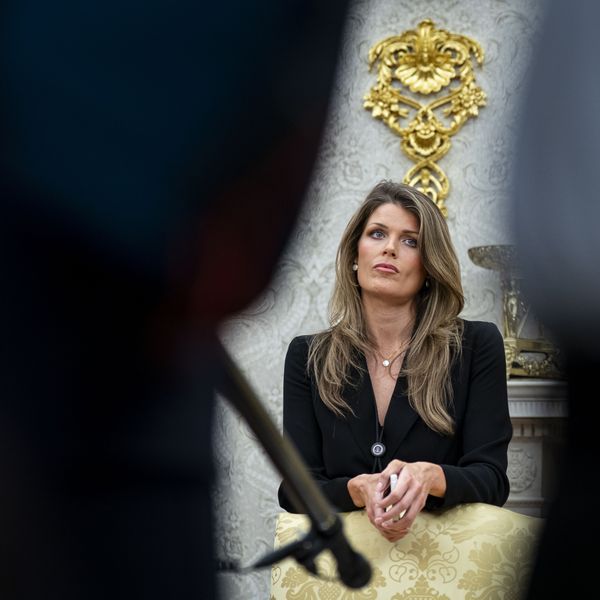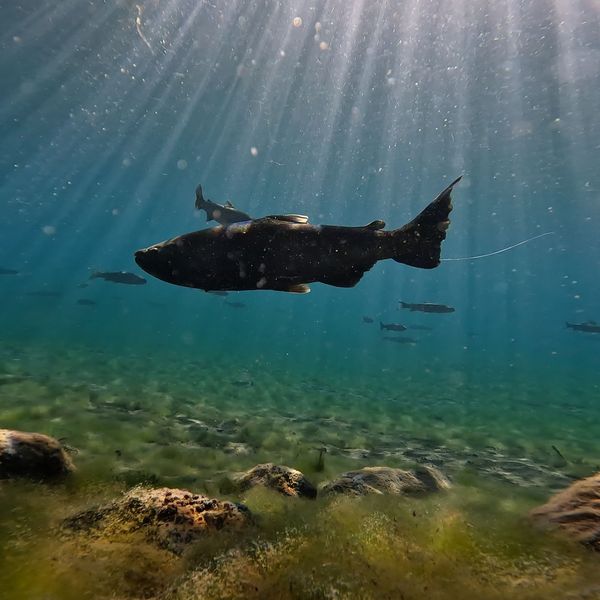Naomi Klein delivered this speech on December 18 at The Opera House in Toronto, at a special production of the Basement Revue to honour Murdered and Missing Indigenous Women.
Listen to an audio recording of Naomi's reading here, with live musical accompaniment from Cris Derksen.
On July 20, 2013, Bella Laboucan-McLean fell 31 stories off the balcony of a condo tower in downtown Toronto. She had been at a small gathering inside one of the building's many glass boxes. There were five other people in the condo that night.
A resident of a lower-floor heard the sound of her body falling and alerted the police.
Bella was 25 years old, Cree from Northern Alberta.
The police deemed the death "suspicious."
I'll say.
Five people besides Bella in an 800 square foot condo. All of Bella's belongings still inside: Purse. Wallet. Shoes. Phone.
Yet for 12 hours after her deadly fall, no one in the apartment calls the police. It is not until the building is crawling with cops going door-to-door, trying to identify the body, that one of those five people picks up the phone to report Bella missing.
Everyone who was there claims they saw nothing. Knows nothing. No one will be a witness.
And yet despite finding these accounts implausible, the police put out no media advisory. It was two weeks before a single story about Bella's death appeared in the Toronto media.
"I can't make anybody talk," the investigating detective told the Toronto Star.
A year and half later, the police have discovered exactly nothing about what really happened that night. The family insists Bella would never have intentionally harmed herself, that she had no history of depression, no drug problem, left no note.
The case remains open.
**
Six months before her death, Bella had been at my house, eating thin-crust pizza, laughing with her big sister Melina, and making faces at my seven-month-old.
Idle No More was rocking the country and Bella was energized. She talked excitedly about making T-shirts for the movement. She was studying fashion at Humber.
Her plan was to become a designer, combining traditional Cree artwork with her own modern flair. She graduated soon after, her dreams, as her family puts it, "within arm's reach."
She danced at pow-wows and beaded; she went to clubs and Instagrammed. She was part of an Indigenous cultural resurgence, a moment of awakening.
**
We held a memorial for Bella at the windy base of the building where she fell, one week after her death.
A group of about 40 of us joined in a circle.
We put up pictures of Bella on a concrete wall. Confident, vulnerable, glowing from within.
We clutched red roses, white candles and little bags of tobacco.
Bella's body had just been returned to her family in Peace River, Alberta. They were, at that moment, beginning the process of laying her to rest. But according to custom, there needed to be a "spirit release" ceremony at the place where she died, to free Bella to continue her journey.
So there we were, two distant points on Turtle Island, connected invisibly by Bella, and the sounds of drums, the smell of sage.
It was Miq-Maq grandmother Wanda Whitebird who led the ceremonies, with help from other community members. All had performed too many such rituals of public mourning before.
Wanda smiled warmly at Bella's impossibly young and fresh-faced college friends. She explained that we should all take our bags of tobacco home and sprinkle their contents somewhere they would feed the life cycle--a garden, a body of water, a potted plant.
"Not here though," she said, "nothing grows in this place."
**
I think most of you know "this place." It's that part of Toronto that feels very much like no place. The official name is CityPlace--the barrage of glass-on-glass condo towers bracketed by the Rogers Centre to the East, the train tracks to the North and Fort York to the South.
The street where Bella died did not exist five years earlier. Neither did the building from which she fell. It's not the density that makes this part of our city strange. It's the monotony of all that newness, the born-yesterday-ness.
The streets and buildings are the same age--give or take a year or two. Most of the people are the same age too--25-35--and are in the same tax bracket. Even the token plant life--scrawny saplings and sparse bushes--all seem to have been planted last week.
More than 11,000 people make their home in this "community," as CityPlace calls itself. But many who live there remark that something is missing--that something being community.
Some complain that their neighbours won't meet their eye. That they push the "door close" button on the elevator when they hear footsteps.
The developers make considerable efforts to fill this nagging absence. With outdoor yoga and Zumba classes. With a farmers' market. With a "CityPlace Got Talent" contest, sponsored by Molson Canadian and Uber.
A block from where Bella died is a brand new $8-million green space called Canoe Landing Park, filled with broad-stroke markers of Canadiana: an oversized fake beaver dam.
Big bright fishing bobbers. That electric red canoe that looks like it's about to launch itself into the Gardner Expressway.
These nautical pieces of urban furniture--designed by Douglas Coupland--are meant to connect the city to the world that was here before the concrete was poured. Remind us that this land used to slope gently down to the lake, where people used canoes, fished and trapped.
Yet it is striking that a park that purports to link Canadians to their past, makes no mention of the First Peoples--the Haudenosaunee, Nishnawbe and Huron Wendat--who actually paddled those waters as a way of life.
At the opening ceremony for the new park, then city councillor Adam Vaughan promised that it would become CityPlace's "heart and soul."
I think it's going to take more than a big red canoe.
It is one of the most painful details of Bella's death that her body fell not onto the street, but into the building's outdoor communal space -- a terrace with scattered with fancy barbeques and mesh furniture. A place meant to help residents meet their neighbours; to build community.
Yet as we gathered to remember Bella, just one person asked us to tell them about the young woman who had died in their midst. Most walked their dogs right past us.
Within an hour of the memorial, all of the tributes to Bella--the pictures, flowers, and candles--had been cleared away. The grey concrete returned to its clean, blank state.
Nobody saw anything. Again.
**
I met Bella through her sister Melina Laboucan-Massimo, a dear friend. Melina is one of this country's most important and inspiring voices speaking out against the health and environmental impacts of the Alberta tar sands. Raising the alarm on tar sands development is personal for Melina. Her father's side of the family is Lubicon Cree and their traditional territory has been devastated by oil and gas infrastructure, poisoned by pipeline spills. The first time we met, Melina described how, more and more, her father was returning from hunting trips with animals whose flesh was yellowed and riddled with tumours.
Two weeks before Bella died, I had been in the tar sands with Melina at the annual Tar Sands Healing Walk. The gathering is like nothing I have seen anywhere: hundreds of people walk in silence for an entire day through an unimaginably scarred landscape: by the sprawling open pit mines, by the massive tailing ponds that kill ducks on contact. Stopping only for prayer and ceremony.
Melina sees strong connections between the two very different kinds of violence that have so powerfully marked her life. "Violence against Mother Earth is violence against women," she says. "The two are inextricably linked."
Here is one link to consider: the greatest barrier to our government's single-minded obsession with drilling, mining and fracking the hell out of this country is the fact that Indigenous communities from coast to coast are exercising their inherent and constitutional rights to say no.
Indigenous strength and power is a tremendous threat to that insatiable vision. And Indigenous women really are "the heart and soul" of their communities.
The trauma of sexual violence saps the strength of communities with terrifying efficiency. So let us not be naive. The Canadian government has no incentive to heal and strengthen the very people that it sees as its greatest obstacle.
Justice, when it comes, will be demanded, not granted.
**
Last week, Melina came to Toronto for work. She said she was ready to see where Bella had died. The night before, I warned her that it was a very unwelcoming place, all hard surfaces and sharp edges. I told her what Wanda had said about nothing growing.
But then something beautiful happened. It snowed all night. The first real snowfall of the year, fresh and fluffy. As we set off that morning the city crawled instead of raced, whispered instead of roared.
It even softened the hardness of that place. Melina said it reminded her of home.
Audrey Huntley from No More Silence smudged and sang quietly. The Filipino security guard used a barbeque lighter to burn the sage.
And Melina sat for the better part of an hour in the exact spot where Bella fell. She craned her neck to look up all 49 stories, snowflakes falling into open eyes.
She grabbed handful after handful of snow until her hands were raw and red.
She wrote, "I love you" next to Bella's name in the powder.
And she breathed one word into the snow-covered city. "Angry."
**
A different word filled my head that day. "Shame."
Shame that this city had failed Bella.
Shame that so many of us still aren't talking. At least not enough. Are failing to be witnesses--as fully as we can be--to the ongoing catastrophe of Murdered and Missing Indigenous Women.
This night is a "celebration of community" in the face of violence.
Because building community isn't just about outdoor yoga and farmers' markets.
It's also about coming together to do the things that will allow us to look each another in the eye.
That means means helping each other to heal, so that we can all heal this land.
It means honouring women and honouring treaties.
And it means joining together to demand justice for the crimes that haunt this country.
You can read more about Bella's case, and support No More Silence, here.
A slightly shorter and edited version of this speech appeared in the Globe and Mail on December 20.




